Uniquely Human
Although we humans are not the only species to exhibit culture, we depend on it in a way that no other species does and no other species demonstrates the cultural virtuosity and flexibility of human beings. In the animal world, transmitting innovations (combining of two or more separate elements into entirely new tools or practices) among peers and between generations of the same group occurs frequently but not necessarily between separate groups of the same species. Moreover, cultural innovation does not seem to occur among non-human species but it is a hallmark of human cultural development.
The first thing to emphasize is that humans are not born with culture like we are born with brown eyes, black hair or freckles. We are born into culture, and we learn it by living in human social groups. In this way culture is something that is transmitted from one generation to the next. This is how we become ‘enculturated. Using archaeological data, is has been estimated that the human capacity for cultural learning emerged somewhere between 500, 000 – 170 000 years ago (Lind et al., 2003) , although some researchers have argued that the predisposition for social cognition, which facilitates social learning, extends farther back in time when we split from an ancient ancestor (Heinrich, 2016; Tomasello, 1999). Other scientists argue that convincing evidence for human culture only appears within the last 100, 000 years (Tattersall, 2015).
Regardless of the time period or mechanism, most researchers, across disciplines, accept that changes, namely in the area of cognition and cooperation led to cultural adaptations and cultural learning among humans.
Describing and explaining which elements of culture are uniquely human is complex, cross-disciplinary and controversial. As this is an introductory text we will limit our discussion to three areas where there is broad agreement on the uniqueness of human culture as it relates to psychology: cognition, cooperation and cumulative learning.
Cognition
It has been argued that cognitive abilities like learning, attending and memory underlie human and cultural evolution (Heine, 2016; Henrich, 2016, Tomasello, 1999) because these abilities make humans better at social learning which, as an adaptation, led to cultural learning. Social learning is best described as learning that occurs in the presence of another person and there are two main forms of social learning: emulative and imitative learning (Heine, 2016; Tomasello & Rakoczy, 2003). Emulative learning focuses on the environment, process and outcomes related to a specific event that is observed. It is an individual style of learning even though there is another person who has modelled the behavior. Humans and nonhuman primates engage in emulative learning. Imitative learning is considered to be uniquely human (Tomasello & Rakoczy, 2003) and occurs through the process of modeling and demonstrating behavior with an understanding of the goal of the behavior. Imitative learning includes intention and reflection of the behaviors, as well as an understanding of the perspective of the person who is performing the behavior. Humans also imitate behavior to fit in and not just to learn, which has not been observed in other nonhuman primates (Tomasello & Carpenter, 2007).
To illustrate the difference between these these two types of social learning, Nagell, Olguin and Tomasello (1993) designed an experiment that required toddlers and chimpanzees to use a tool (rake) to retrieve an object that they really wanted (a toy for the children and food for the chimpanzees) that was out of their reach. Each group was shown how to use the tool to retrieve the object – but there was a slight variation to the experiment. One group was shown how to use the rake teeth down which was effective but not efficient. The other group was shown how to use the rake teeth up which was both effective and efficient. The toddlers used imitative learning and copied the behavior they had observed, either teeth up or teeth down. The chimpanzees used the teeth up situation, regardless of what they observed and were more successful in reaching the food. The chimpanzees used emulative learning which was the most effective and efficient way to learn and solve problems. Additional cognitive research has confirmed that on some measures of thinking, apes were smarter than human adults (Martin, Bhui, Bossarts, Matsuzawa, & Camerer, 2014) and children (Herrmann et al., 2007).
In a series of cognitive experiments chimpanzees, orangutans and 2-year old toddlers were compared on measures of physical problem solving and social problem solving. Toddlers were used in the experiment because human adults would have performed significantly better than the apes across all cognitive measures (we call this the ceiling effect). Results revealed that on measures of physical problem solving, apes and toddlers performed about the same.
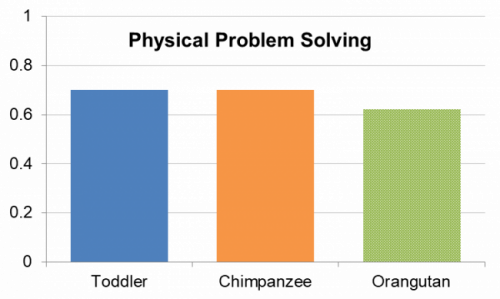
On social problem-solving tasks that required the participants to engage in social learning, toddlers outperformed the apes. There was really no competition. Results from comparative studies like these suggest that humans are not intellectually superior (at least when compared to apes) except in the area of social learning that included elements of imitative learning. Attending to events, modeling the behaviors of others, learning from others and storing the knowledge for later use and problem solving is central to imitative learning and essential for cultural learning and cumulative culture.
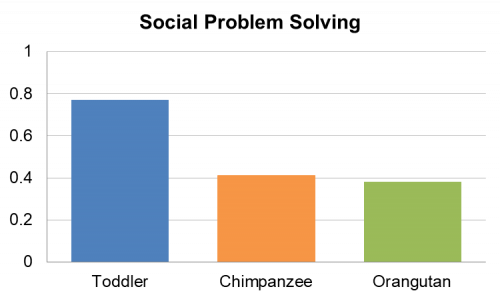
Much of the research examined so far has compared human toddlers to nonhuman primates; however, there is a growing body of developmental literature that confirms the importance of social learning. Cross-cultural research in the area of developmental psychology has demonstrated that human infants selectively attend to several important cues like prestige (who does it best), sex and ethnicity (sound and look like me) and familiarity (similarity in background). The research has also demonstrated that learning these cues seems to happen at about the same time in human development and in about the same order across cultures. Cues and social learning are not just for infants. Researchers examined undergraduate student performance and cues related to sex and ethnicity. After controlling for other variables, results showed students who receive instruction from faculty of the same sex, ethnicity or race were less likely to drop out and had better grades (Hoffman & Oreopoulous, 2009; Fairlie, Hoffman & Oreopoulous, 2011). These studies suggest that interpretation, motivation and understanding cues appear to have significant implications for early childhood development, as well as later adoption of adult roles.
Relatively recent autism research has provided an opportunity to explore the role of cues and attending even further. Autism research suggests that children with autism who miss out on these stages of attending have significant difficulty with social cues (Tomasello, Kruger, & Ratner, 1993). Additionally, children with autism have great difficulty sharing emotional states or understanding the intentions of others (Tomasello et al., 2004). By sharing intentions humans are able to experience events and perspectives together at a level not seen among our closest animal relatives (Tomasello, et al., 2004). Shared intentionality is a cognitive process by which we see others as intentional agents. Shared intentionality encompasses interactions, commitment to a goal, and cooperation with others to achieve the goal, which are necessary elements for cultural learning and cultural adaptations (Heine, 2016; Tomasello et al., 2004).
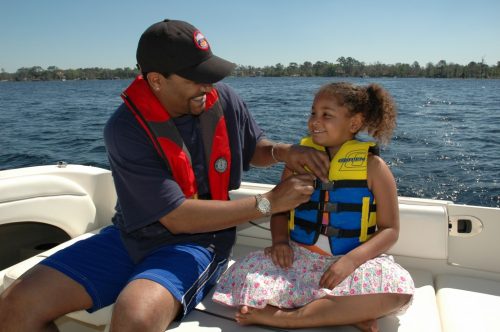
Cooperation
The ability to work together toward common goals is required for the survival of any group. There is strong evidence that nonhuman primates (our genetic cousins) cooperate but that it is limited to kin or partners with few documented cases of cooperation with intergroup members (e.g., strangers) (Melis and Semmann, 2010). Cooperating with strangers to complete complex goals appears to be a uniquely human behavior and there are several explanations for these phenomena, including cognitive skills, protection from conflict and the development of social norms.
Cognition
As discussed earlier in the previous section that humans have a unique ability to engage in social learning (Boyd, Richerson & Henrich, 2011; Hermann et al., 2007; Tomasello, 1999), as well as other psychological advantages including memory which helps us to track who helped us and who we have helped (Hauser et al., 2009; Melis and Semmann, 2010). Perhaps most importantly, we are able to transfer all this information to others in our group, which means that as an individual you might gain a reputation for being a helper or gain a reputation for being a loafer (more about this in Chapter 11).
Protection
Cooperation may also have emerged as a result of external pressures (e.g.,intergroup conflict, climate change, competition) which facilitated the formation of large groups. Bowles and colleagues (2013) suggest that competition with other groups brought about social changes and groups who were better at cooperating were more likely to survive. Additionally, our ancient ancestors were more likely to be prey than predator and being part of a large group offered some protection from predators (Hart & Sussman, 2009; Henrich, 2016). Dunbar (1993) has proposed that because early humans began living in large communities, language (a cognitive product) was developed. He suggests that humans required the use of complex communication to maintain social cohesion and unity among group members.
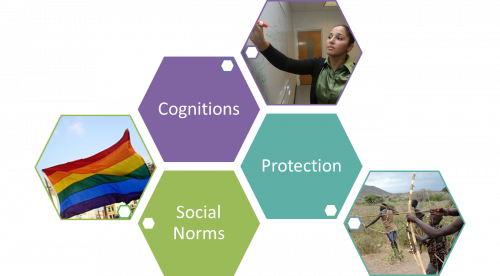
Norms
As groups became larger, humans established social rules or norms (Richerson & Boyd, 2008). Henrich (2016) argues that social norms within groups emerged because of our unique cognitive abilities for social learning (e.g., to learn from someone else). By observing a model of appropriate behavior, humans learn what behavior is unacceptable and those individuals who do not follow these social rules are often sanctioned (punished). Cooperation has spread across populations because of social norms that sanction intergroup conflict and promote fair treatment of group members. Research with infants less than a year old appears to support this argument.
Hamlin and colleagues used a puppet morality play in an experiment with infants and toddlers that found children preferred people who help others reach a goal (prosocial behaviors) and avoided people who were harmful, or who get in the way of others reaching a goal. As early as 3 months old, humans are evaluating the behaviors of others and assigning a positive value to helpful, cooperative behaviors (Hamlin et al., 2007; Hamlin & Wynn, 2011) and negative values to harmful or selfish behaviors.

[Image by Senior Airman Marcy Copeland; Child daycare https://www.luke.af.mil/News/Article-Display/Article/640868/cdc-mission-includes-playtime/]
Prosocial behaviors and social norms that reward cooperation and helping become automatic overtime and are reflected in everyday choices that we make as adults. For example, Rand and colleagues used the Public Goods Game, an economic experiment, to examine cooperation and competition (Rand, 2016). In the game, participants decide how much to contribute to the public good and if all participants contribute then the payoff is greater for the entire group.
Early findings revealed that participants who made their contributions faster gave more to the public good (greater cooperation). These results were consistent in several replications (Cone & Rand 2014); when forced to make a quick decision, participants cooperated more than when asked to reflect on their decision. It seems that under certain circumstances, social contexts and social norms, ‘going with your gut’ leads to increased cooperation (Henrich, 2016).
Cumulative Learning
We read earlier in the chapter that animals have cultural transmissions but only humans seem to have the ability for cumulative cultural changes that result in behaviors that no one single person could have learned individually through a lifetime of trial and error. We call this cumulative cultural learning which refers to human collective brain power (Tomasello & Moll, 2010) or a set of sophisticated skills that we possess (Henrich, 2016) which allow us to create practices, behaviors, norms, artifacts (things) and institutions that are retained by group members and transmitted across generations and to other groups.
Humans can use this collective brain power for novel problem solving in order to adapt to changing environments and social conditions. Boyd, Richerson and Henrich (2011a) go even farther and suggest that culture is part of our human biology because our brains and our bodies have been shaped and influenced across thousands of years in ways that promote the accumulation and transmission of knowledge.
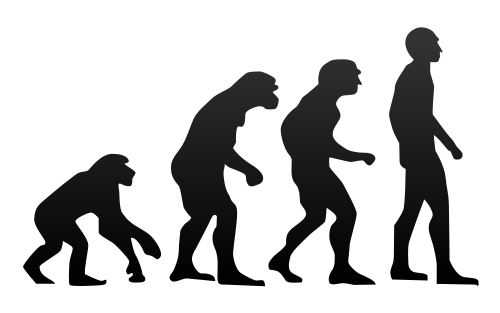
Many researchers suggest that cumulative cultural evolution results from a ratchet effect that began when humans developed the cognitive infrastructure and processes to understand that others have intentions so people can engage in coordinated efforts to achieve complex and specialized tasks (Tennie, Call, & Tomasello 2009). The ratchet effect suggests that cultural adaptations and innovations are accumulated (become part of a larger library of knowledge) and then are expanded upon and refined across generations.
There are historical examples of cultures who have lost accumulated culture. Henrich (2004) details the experiences of Tasmanian islanders and explains using a mathematical model how cultural learning can be lost. History and social context are important here – humans arrived on Tasmania, from Australia (conceivably), about 34,000 years ago by crossing a land bridge that was later covered by rising ocean levels. Using archeological evidence, it seems that the early Tasmanians (roughly 70,000 inhabitants) had a sophisticated toolkit with hundreds of tools and a set of skills for hunting different animals. When eighteenth century explorers arrived in Tasmania the population had declined, the toolkit had only 24 tools and the diet had significantly less variety than the early Tasmanians. Henrich argues that the loss of knowledge happened because Tasmanians did not attend to the best models or teachers (or there were fewer skilled people) and the products that were created were imperfect. Over time, skills were lost and knowledge was lost which resulted in a loss of accumulated knowledge. There are examples of cultural loss in North America among native populations; however, these examples are not the result of natural selection or ecological pressures. In most cases, cultural loss was brought about through external forces including colonization, subjugation and the enforcement of policies to limit transmission of cultural values, practices, rituals and language (UNESCO) of most native populations.
It is generally accepted that innovations and the accumulation of cultural learning occurs at a faster rate with larger groups that have greater interconnection. These ideas were tested in a laboratory experiment that used college students and a computer game (Derex, Beugin, Godelle & Raymond, 2013). Students were shown a complicated fishing net and then asked to design the same net using a computer. Students were assigned to groups that range from 2 to 16 members and each player had 15 attempts to design the net. Students earned points based on the quality of their work. To mimic social learning, students were able to select a model created by other group members. Researchers found that members of a larger group were more likely to complete the fishing net accurately with fewer trials. The researchers assert in larger groups there were more models to learn from. This lab experiment along with scientific observations reveal that in a large group it is more likely that someone will come up with a great idea that can be maintained and improved by the group (Heine, 2016) and the learning process moves quicker.
Summary
Comparative animal studies and developmental research are generally seen as support that human brains come preprogrammed with a host of cognitive abilities that have helped us to adapt and survive (Henrich, 2016). Some researchers also believe that human cognitive ability evolved genetically so that we would become better learners, individually, as well as better at learning from others by figuring out what people (e.g., teacher, expert or model example) want us to do or know (Henrich, 2016). This has important implications or consequences for our interactions with others, including cooperative behaviors. Prosocial behaviors are learned through the cognitive processes we discussed earlier, like attending, imitating, as well as through social learning. Social norms that reward cooperation and helping become automatic overtime and contribute to large group cohesion and unity. Large groups with high interconnection are less likely to experience loss of accumulated knowledge and more likely to innovate and adapt to ecological stress and other selective pressures.

